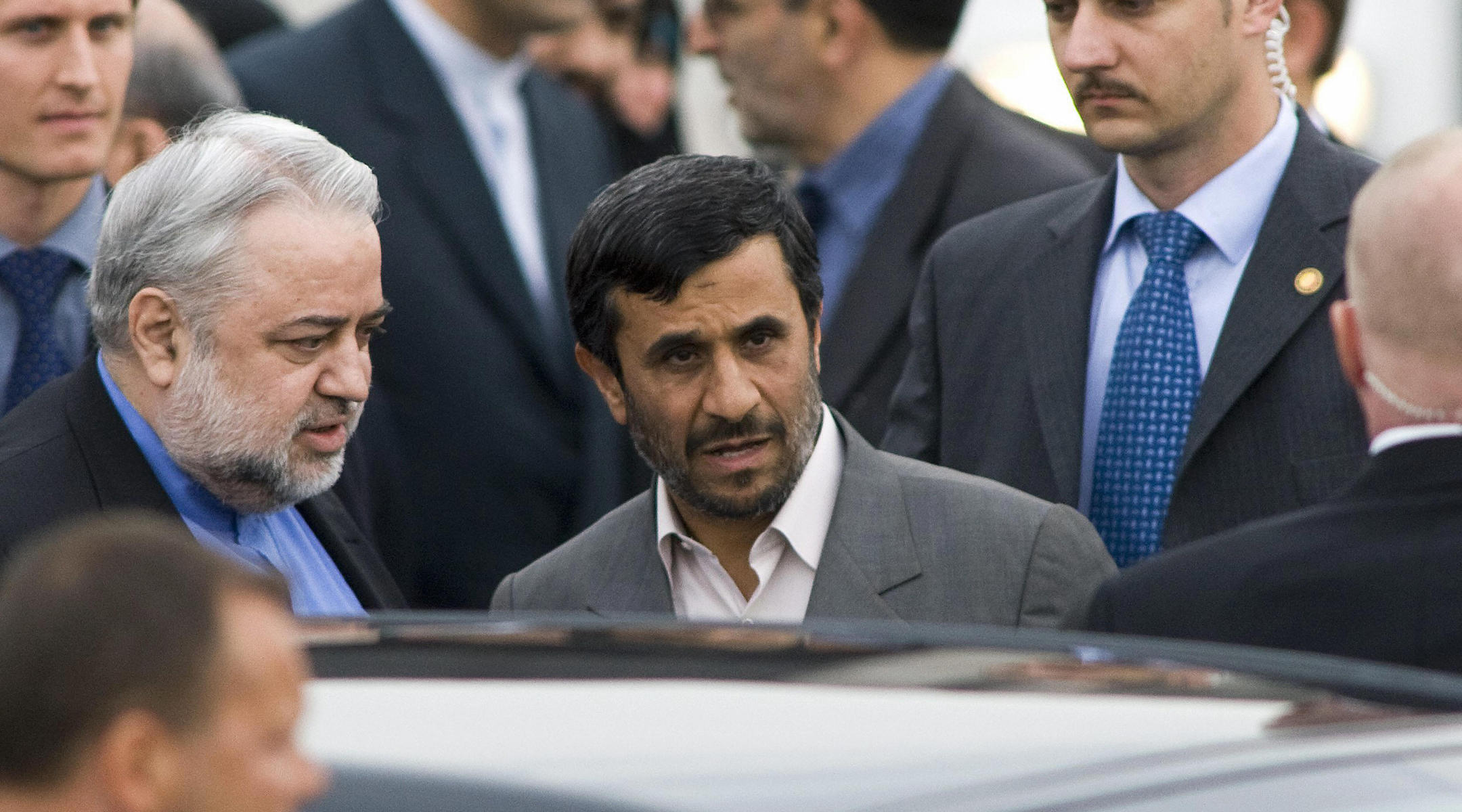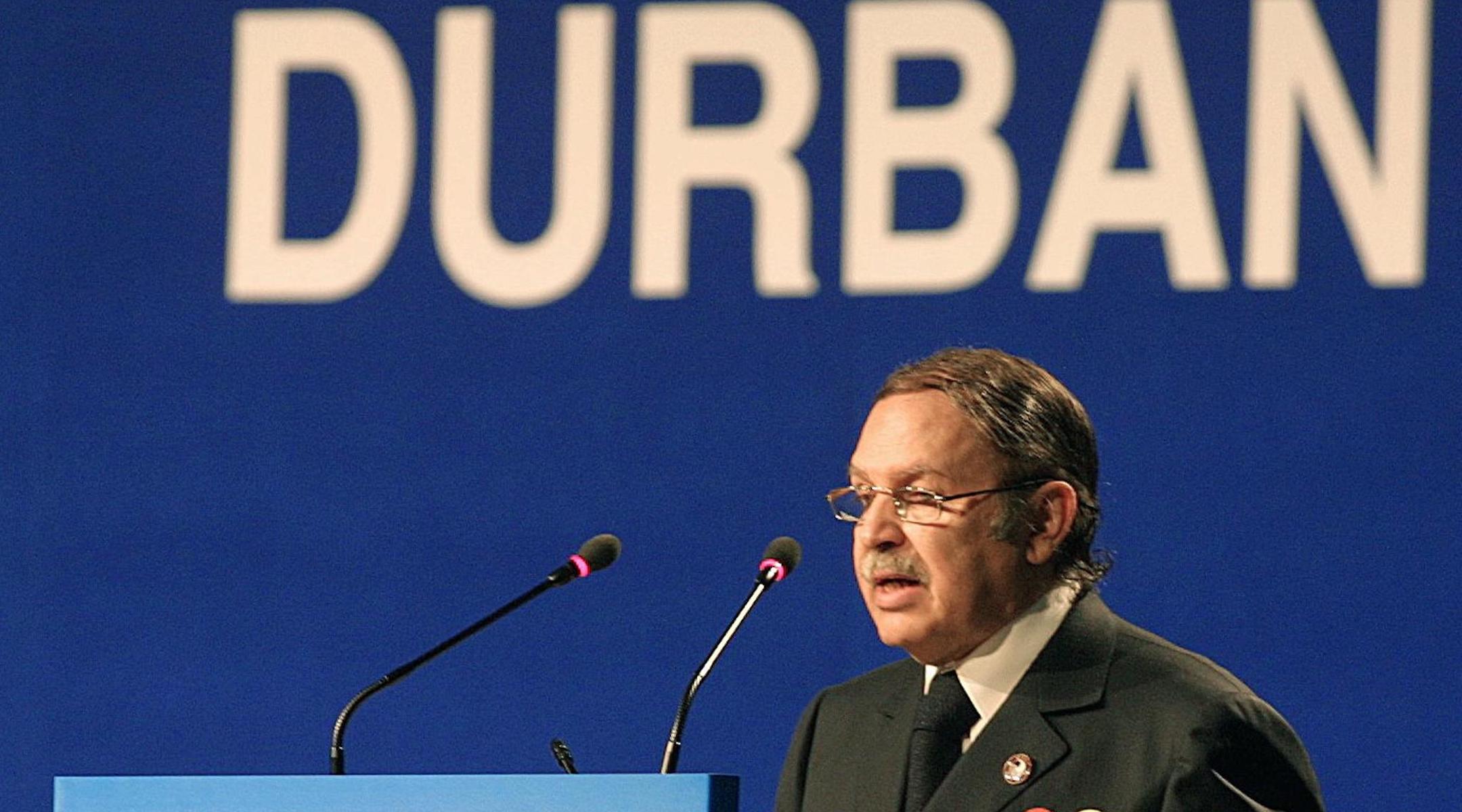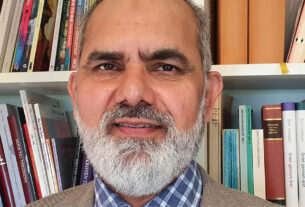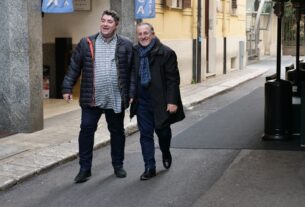(JTA) — Some of the Jewish organizational officials flying into the coastal city of Durban, South Africa, on the last week of August 2001 were excited. They believed the U.N.’s anti-racism conference there would be an opportunity to exchange notes on a cause that the Jewish world had worked on for decades.
Others, steeped in how the United Nations and its affiliates functioned, were wary of some of the players, who were known for tirelessly steering every international conference to complaints about Israel. Still others who had been tracking preparations for the gathering knew that Iran, Israel’s implacable enemy, was planning to take over the proceedings.
But no one was prepared for what it became — a carnival of antisemitic expression that drove Jewish participants to tears each night and had them fearing for their physical safety.
“It was worse than I had imagined,” recalled Irwin Cotler, a longtime Jewish human rights lawyer in Canada who would go on to be his nation’s justice minister. “Because it was a festival of hate.”
As is conventional at U.N. forums, the governmental conference, which ran Sept. 2-9, was preceded by the nongovernmental organization conference Aug. 27-Sept. 2.
Both would be overshadowed by the 9/11 terrorist attacks. But the NGO conference, say the Jewish participants who attended, was a template for the next 20 years of anti-Israel rhetoric, codifying the argument now increasingly prevalent on the left that Israel is an apartheid state deserving of isolation. It was also an eye opener for many in terms of how criticism of Israel, however legitimate, can be co-opted by an antisemitic agenda.
The failure of the human rights organizations present to come to the defense of the Jewish participants, who walked out to jeers and threats, created a rift that persists until today. Over a dozen countries, including the U.S., Canada, Germany, France, Italy and the United Kingdom, are boycotting this year’s Durban conference over its antisemitic history.
The Jewish Telegraphic Agency spoke to nine Jewish officials who were at the 2001 conference, including Cotler, who was then a member of the Canadian parliament.
The others are:
— Stacy Burdett, then the associate government relations director at the Anti-Defamation League;
— Rabbi Abraham Cooper, associate dean of the Simon Wiesenthal Center;
— Felice Gaer, director of the American Jewish Committee’s Jacob Blaustein Institute for the Advancement of Human Rights;
— Richard Heideman, then the president of B’nai B’rith International;
— Phyllis Heideman, his wife, who had attended a number of U.N. conferences as a delegate of B’nai B’rith;
— David Killion, then the chief of staff to Rep. Tom Lantos, D-Calif., the only Holocaust survivor ever elected to Congress, who headed the U.S. delegation to the governmental conference;
— Eduardo Kohn, the B’nai B’rith International director of Latin American Affairs;
— A top Jewish organizational official at the time who is now in a job where she is not permitted to speak on the record.
Heading into the conference: “There was a little bit of naivete going into it.”
Cotler: “In 1997, when it was first announced that there was going to be a world conference against racism in South Africa in 2001, I greeted it with anticipation, if not excitement, because this was going to be the first world conference against racism in the 21st century, and I felt that it would give underrepresented groups a voice and a presence. Second, it was going to be the first international human rights conference of the 21st century. Human rights had emerged as a new secular religion of our times, and this conference would be as timely as it would be significant. And third thing is, it was taking place in Durban, South Africa. I not only had a longtime involvement in the anti-apartheid movement but actually had been arrested.” [Cotler was arrested in apartheid South Africa in 1981 for delivering a lecture at a university in which he said that Nelson Mandela had as much right to freedom as Natan Sharansky, then a prisoner in the Soviet Union whom Cotler represented as a human rights lawyer. He went on to lead anti-apartheid advocacy in Canada.]
Burdett: “I was born in 1964, so for Americans of my age, it was like the antisemitism was over, right? So there was this aspect of, in preparing for Durban, my focus was trying to make sure ADL got a good spot for doing events on our anti-racism trainings. So there was a little bit of naivete going into it.”
Richard Heideman: “In 1985, there was a U.N. conference to assess and appraise the status of women that was held in Nairobi, Kenya. Phyllis was designated as a delegate by B’nai B’rith International, which is the oldest Jewish organization with standing at the U.N. When we arrived in Nairobi we found at the NGO forum and at the U.N. conference itself terrible hatred toward Israel and the Jewish people.”
The 1975 U.N. General Assembly resolution equating Zionism with racism permeated the Nairobi conference. In 1991, years of Jewish organizational advocacy and U.S. diplomacy brought about the revocation of the resolution, fueling hope that Israel would not be a focus at Durban.
Gaer: “We had a secretary-general who, for the first time in the history of the U.N., actually used the word ‘Holocaust,’ who was married to the niece of one of the great Holocaust-era heroes. [Kofi Annan, who was instrumental in the establishment of International Holocaust Remembrance Day, was married to Nane Lagergren, whose uncle was Raoul Wallenberg, the Swedish diplomat whose actions saved thousands of Hungarian Jews.] And we had expectations that a world conference on racism could not only address the scourge of racism, which we have seen in such ugly ways in the former Yugoslavia, the Bosnia conflict and in Rwanda, but that could also address race issues in individual countries. Those of us who were engaged in Jewish organizations also felt this was an opportunity in which we could talk about combating antisemitism as one of a whole variety of forms of intolerance and racial discrimination and racism that needed to be eradicated.”
Cooper: “The truth is that when we went, we’d already seen storm clouds [after Iran maneuvered to set the agenda at a preparatory meeting in February], although no one had any clue about how bad it would be on the ground, how terrible it would be on the ground.”
Iran and a striking image set the stage
In retrospect, there were signs that there were actors intent on making Israel a focus of the conference. The main conference was preceded in late 2000 and early 2001 by regional conferences. The final regional conference, for Asian countries, took place in Tehran in February 2001. Iran refused to allow Israelis and Jewish organizations to attend.
The Simon Wiesenthal Center, another Jewish organization accredited at the United Nations, asked the U.N. human rights commissioner — Mary Robinson, the former president of Ireland who was organizing the conference — to move the venue to another Asian country. Robinson declined but pledged that she would make the Iranians allow Jewish and Israeli representatives to attend.
Cooper: “Mary Robinson promised us up the wazoo, ‘You guys have every right to attend the meeting in Tehran.’ But we didn’t get the right to go until after the last planes from Paris and New York left for Tehran so that it would be impossible for us to reach there. And that’s where a lot of the stuff was cooked.”
Whereas Jewish and Israeli delegates could influence summary statements at regional preparatory conferences in Africa, Latin America and Europe, Iran’s maneuver meant that the Asian summary document amounted to an indictment of Israel. It accused Israel of “ethnic cleansing,” of implementing “a new kind of Apartheid” and “a crime against humanity,” and said Zionism was “based on race superiority.” Much of the Iran-influenced document became a template for the NGO declaration at the Durban conference.
Cotler: “There was a six-point indictment of Israel at the regional conference in Tehran, one of the most scurrilous indictments of Israel since the end of the Second World War.”
The Second Intifada had been underway for almost a year by the time the conference started, and one of its most striking images, caught on video, persisted: The Sept. 30, 2000 killing of Muhammad al-Durrah, a 12-year-old Palestinian caught in the crossfire during a battle between Israeli and Palestinian forces. Images of al-Durrah proliferated at the conference, including on T-shirts. “Killed on September 30 2000, for being Palestinian,” a T-shirt said on one side. On the other side it read “Occupation = Colonialism = Racism. End Israeli apartheid.”
Burdett: “The Palestinians really had an edge here because they have the popular vote. There were pictures of Muhammad al-Durrah everywhere. They had the sympathy vote.”
Richard Heideman: “What we faced was phenomenal in terms of the visible expression of hatred, not just placards but photographs, and talking about Jews and Israelis as murderers.”
Burdett: “There was an NGO kind of infrastructure managing this [on the South African end], a South African NGO that received large grants from the U.N. [SANGOCO, a coalition of South African NGOs]. And even before Durban started they did a mission for NGOs for the West Bank, so there was a lot of writing on the wall.”
“I saw grown men crying, weeping.”
Not long after they landed, the conference-goers noticed a ubiquitous flyer with a picture of Adolf Hitler. “WHAT IF I HAD WON?’ it asked. “The good things: There would be no Israel and no Palestinian’s [sic] bloodshed. The bad things: I wouldn’t have allowed the making of the new Beetle. THE REST IS YOUR GUESS.”
The Arab Lawyers Union also distributed pamphlets filled with caricatures of hook-nosed Jews depicted as Nazis spearing Palestinian children, dripping blood from their fangs, with missiles bulging from their eyes or with pots of money nearby. Copies of “The Protocols of the Elders of Zion,” a notorious antisemitic text, were available. Calls to the organizers to remove the materials went unheeded.
The confrontational imagery was reflected in personal encounters. Protesters surrounded Jewish students who set up a stand near the press tent and screamed at them.
Kohn: “We couldn’t speak out in the meetings because in the moment we started speaking — any Jewish delegation — the shouts of ‘You kill the Palestinians, you’re like the Nazis you’re a racist, apartheid’ and whatever — it made us impossible to speak out.”
Cooper: “The Lawyers Guild from Egypt did political cartoons that literally would have belonged in Der Sturmer. Our attempts to get them removed were basically laughed at. So we called a press conference. At that press conference, before we started, a phalanx of Iranian women in black rush the press conference and try to push over the shtender [podium] and try to kill the press conference. They were eventually physically removed. So the physical intimidation was there.”
Kohn: “There was a Uruguayan minister [Education Minister Antonio Mercader] who came up to me and said it was risky, we need protection. I mean it was unbelievable. We were at a U.N. conference.”
On Friday, Aug. 31, the Jewish delegation learned that South African unions were staging a massive pro-Palestinian demonstration at the conference grounds, the Kingsmead Cricket Stadium. Security officials warned Jewish participants to stay away.
Cooper: “I was approached by the chief of police of Durban and told the following: ‘Rabbi, please, I’m asking you, do not try to go from here to the Jewish community center today.’ ‘Why not? It’s like 2 1/2 blocks away.’ He said, ‘We cannot guarantee your safety.’ And just then when we looked out — we went up higher [in the stadium] — 20,000 people have been brought in by train by the trade unions in order to do Israel apartheid protests, in which the famous picture of the banner ‘Hitler was right’ was hoisted. They were giving out free copies of the ‘Protocols of Zion.’”
Burdett: “We had put out an SMS to everyone’s cellphone, ‘Do not go near that demonstration’ because our information is that it’s going to be heavily laced with and motivated by antisemitism and that we should not be visible. They were carrying signs and wearing T-shirts that said ‘Apartheid Israel.’ Someone had gone to the townships and just distributed T-shirts to people who just could use a shirt to wear. And so that street demonstration was just filled with people wearing freshly minted anti-Israel T-shirts. And so the effort to make Israel such a prominent issue at this conference was very organized.”
Cooper: “The one lifeline for the Jewish groups was the Jewish community center of Durban. That was the place we came at night to lick our wounds, where I saw grown men crying, weeping. It was that bad.”
The walkout
On the evening of Saturday, Sept. 1, the conference-goers convened to work out the final text of the NGO declaration. It was a chaotic scene, but the steering committee achieved a modicum of order by allowing each group to propose an amendment that defined the discrimination they suffer. That prompted the Jewish delegation to propose an amendment that pushed back against the conference’s anti-Zionism and referenced the spike in worldwide antisemitism after the start of the Second Intifada.
It said: “We are concerned with the prevalence of anti-Zionism and attempts to delegitimize the State of Israel through wildly inaccurate charges of genocide, war crimes, crimes against humanity, ethnic cleansing and apartheid, as a virulent contemporary form of antisemitism, leading to the firebombing of synagogues, armed assaults against Jews, incitement to killing and the murder of innocent Jews for their support for the existence of the State of Israel, the assertion of the right to self-determination of the Jewish people and the attempts through the State of Israel to preserve their cultural and religious identity.”
The conference overwhelmingly rejected the amendment, with only delegations from Central Europe and the Roma joining the Jewish delegation in favoring its inclusion. That was a breaking point. The entire Jewish delegation rose to leave, and the crowd erupted in shouts and threats.
Richard Heideman: “We were walking out in a procession with people jeering us on the sides.”
Kohn: “While we were walking we received very, very, very rude insults, antisemitic insults and the threats of being attacked, I mean attacked physically, attacks that were averted by the guards of the conference, I mean, if we didn’t have the protection of the guards …”

Then-Iranian President Mahmoud Ahmadinejad called Israel “racist” at the 2009 Durban Conference. He is pictured here with Ali Reza, the head of Iran’s mission to the United Nations in Geneva. (Salvatore Di Nolfi/AFP via Getty Images)
The repercussions
The George W. Bush administration sent a delegation to the government portion of the conference led by Rep. Tom Lantos, D-Calif., the ranking member on the U.S. House of Representatives International Relations Committee. (Lantos died in 2008.)
At the behest of the Bush administration, Lantos led a walkout from the conference on Sept. 3. In an influential account of the Durban conferences published in 2002 in the journal of Tufts University’s Fletcher School of International Affairs, Lantos laid out the reasons for the walkout, chief among them Mary Robinson’s insistence on including in the governmental declaration mention of the Israeli-Palestinian conflict — the only such conflict singled out for mention.
He also cited the NGO conference debacle leading into the governmental conference as a spur. In three hard-hitting paragraphs Lantos, who had saintly status among Jewish groups, forever changed how those groups related to human rights NGOs.
“NGOs can’t always be counted on to promote liberal values,” the lawmaker wrote. “The leaders of the great Western human rights NGOs like Human Rights Watch, the Lawyers Committee for Human Rights, and Amnesty International participated in the NGO Forum in Durban. Shockingly, they did almost nothing to denounce the activities of the radicals in their midst. They made no statements protesting the debasement of human rights mechanisms and terms taking place in front of their eyes and they offered no support to the principled position that the Bush administration took against the singling out of Israel and Jews for attack and criticism at the conference.”
Killion: [Lantos’ chief of staff wrote the final version of the Fletcher article and went on to be a U.S. ambassador to UNESCO.] “The role that the United States was playing to level the playing field for Israel was just absolutely critical. It was done at the level of the government [because] the NGOs weren’t helping. And I sort of became passionate about that for the rest of my career and I was able to practice that at UNESCO.”
The NGOs objected to the Fletcher journal in a letter, saying they had spoken out in a press conference and that Lantos ignored the accomplishments of the conference: Elevating the international discussion about the legacies of slavery, and shining a light on oppressed communities that had not been receiving attention, including the Roma and the Dalit. But the tone was set.
Killion: “Tom Lantos was a very tactical and strategic guy. I mean, he was upset at their behavior. And calling it out, making it public, he would have hoped that it would, you know, be a productive thing to drop this bomb, and unsteady them and create some thought and maybe some change.”
Former Jewish organizational leader: “Tom Lantos, a lot of what he said was spot-on. But the characterizations of the NGOs was actually wrong.” [The NGOs said the conference was wide ranging with simultaneous workshops, and that they did not notice every instance of antisemitism.] “Your head was in the conference you saw, and it might have taken a couple of hours to hear what’s going on in the other places. But then [Lantos’ account] becomes the narrative and the history, and at that time and over the past two decades, where the Jewish community should have doubled down on community relations, they walked away. Lesson learned in terms of who writes the narrative: Lantos wrote a narrative that trashed some of the partners the Jewish community should have been spending the last 20 years working with. And I think that’s an unfortunate piece.”
Burdett: “It was a watershed moment that had two different parts of the Jewish community with two divergent takeaways and responses. And that divergence still animates a divide on how the Jewish community responds to antisemitism in progressive movements. A big group of people saw Durban as a warning that antisemitism never goes away, we can’t rely on others. And then a second group of people saw Durban as a warning that we have a lot of work to do to reestablish antisemitism as a human rights violation, that we have a real challenge with how to situate Jews in the civil rights and racial justice movement, because a majority of Jews still today consider that movement their moral and ideological home. So Durban forced these tough questions that we’re dealing with 20 years later.”
The NGO declaration, finalized after the Jewish delegates left, called Israel a “racist nation,” pushed for reinstating the equation of Zionism with racism and accused Israel of genocide. Robinson, the U.N. human rights commissioner, decried the language and refused to formally hand the voluminous final declaration to the governments as their conference began, which was unprecedented.
Cooper: ”The final document that was voted on after we left was so bad that Mary Robinson herself rejected it and never gave it over to the U.N. countries. It sank Mary Robinson.” [Robinson had hoped to become the first female U.N. secretary-general, but those ambitions were scuttled largely because of the Durban debacle.]
Yet the final document was not quite a failure, according to these participants. It created a narrative about Israel that has now been mainstreamed on the left.
Cooper: “The resurrection of ‘Zionism is racism,’ everything we’re struggling with today, that script was written and finalized under the supervision of 3,600 NGOs. There’s no BDS [the movement to boycott, divest from and sanction Israel] movement without the building blocks of demonization of Israel in the global scheme of things at Durban. The narrative we’re all struggling with today was written back then.”
Cotler: “The indictment of Israel as an apartheid state was born in Durban. It was triggered in Durban. Durban became the tipping point for the demonological antisemitism that we see today, where Israel is blamed for all the evils of the world, that Israel and the Jewish people are the enemy of good, the embodiment of all those evils. My wife always says I came back from Durban transformed.”
Burdett: “This was an anti-Israel message that had no guardrails. It went right to Jewish control, and there were no guardrails.”
Gaer: “The Durban conference was definitely a turning point for many, particularly for a certain generation of Jewish leaders. And also because it was the most visible display of antisemitic behavior … trying to normalize this kind of behavior has made it something that you have to address, speak out about.”
Then came 9/11
Former Jewish organizational leader: “There were some headlines on the ninth, Sept. 9, 2001. And it had to do with the guy who paid for one of the worst posters, ‘What if I had won,’ and it’s a picture of Hitler. Basically it was someone who worked for bin Laden, and I’d never heard of bin Laden before Sept. 9.” [Yousuf Deedat, who printed the flyers, told newspapers that the bin Laden family was a major donor to his organization, the Islamic Propagation Center.]
Cotler: “I arrived in Montreal on September the 10th that evening, and woke up in the morning to 9/11. I spoke to a colleague and she said to me 9/11 was now the Kristallnacht of terror and Durban was the ‘Mein Kampf.’ Those of us who were at Durban would have understood that statement because it was the blueprint, the tipping point, the trigger for the old-new global antisemitism that we’re now experiencing.”
Gaer: “Durban … has become a cultural landmark and political landmark.”




